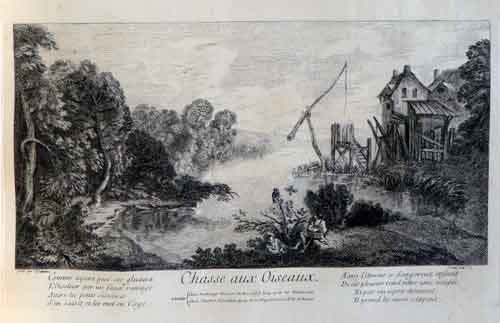
- Home Page
- Accepted
Paintings & Copies - Doubtful
Attributions - Doubtful Textual References
- Alternative
Titles - Collectors &
Museums - Bibliography
- Search Abecedario
- Watteau &
His Circle
La Chasse aux oiseaux
Entered December 2017

Presumed lost
Oil on canvas
Approximately 50.8 x 96.5
RELATED PRINTS

La Chasse aux oiseaux was etched by the comte de Caylus and then was finished by François Joullain for inclusion in Jean de Jullienne’s Oeuvre gravé. The pendant engraving, also first etched by Caylus and finished by Joullain, is after Watteau’s Acis et Galathée, a landscape that is not particularly similar in composition or theme.
PROVENANCE
Paris, collection of Charles Antoine Coypel (1694-1752; painter and director of the Académie royale de peinture). His sale, Paris, 1753, lot 81: “Deux Paysages de meme grandeur & pendants, peints sur toile par Antoine WATEAU, qui paroît y avoir voulu imiter la maniere de Forest; l’un représente une Chasse aux oiseaux, & dans l’autre est Acis & Galathée: ils ont été graves par le Sieur Joullain, & sont d’un grand effet. Ils portent chacun 20 pouces de haut sur 3 pieds 2 pouces de large.” The pair sold for 50.10 livres according to an annotated copy of the catalogue in the Rijksbureau voor Kunsthistorische Documentatie.
The paintings do not appear in subsequent eighteenth-century sales.
SELECT BIBLIOGRAPHY
Goncourt, Catalogue raisonné (1875), cat. 191.
Goncourt, L’Art du dix-huitième siècle (1880), 58.
Josz, Watteau (1903), 120.
Josz, Watteau (1904), 51.
Dacier, Vuaflart, and Hérold, Jean de Jullienne et les graveurs (1921-29), cat. 62.
Réau, “Watteau” (1928), cat. 23.
Dacier, "Vente Coypel" (1932), 71-72.
Adhémar, Watteau (1950), cat. 159.
Mathey, Watteau, peintures réapparues (1959), 66.
Macchia and Montagni, L’opera completa di Watteau (1968), cat. 18.
Ferré, Watteau (1972), 3: cat. B58.
Roland Michel, Watteau (1981), cat. 107.
Roland Michel, Watteau (1984), 151, 160, 257.
Eidelberg, “Dans ses lieux” (2001), 179-84.
REMARKS
In his "Notes manuscrites," Mariette commented that in this picture and its pendant, Acis et Galathée, Watteau “paroît y avoir voulu imiter la manière de Forest.” The landscape painter Jean Forest (c. 1634-1712) was then considered to be the finest landscape painter that France had ever produced. Pierre Crozat, Watteau’s patron, owned eight paintings by Forest, including two into which Watteau inserted figures of his own invention (see Paysage de Forest avec figures de Watteau). The painter Charles Coypel owned not only Watteau’s two pendants of La Chasse aux oiseaux and Acis et Galathée but also fourteen landscapes by Forest, probably the result of his father’s friendship with Forest. Others in Watteau’s circle, such as Antoine de la Roque, the editor of the Mercure de France and Watteau’s first biographer, owned a Forest landscape. A tantalizing clue to Watteau’s link to Forest lies with Nicolas Claude Henin (1679-1763), conseilleur de Roi, maître et doyen de la Chambre des comptes de Paris, and maître d’hôtel ordinaire du Roi. Nicolas Claude Henin was an amateur painter and Forest’s only acknowledged student. Although we cannot specify the exact relationship, he must have been related to Nicolas Henin (1691-1724), one of Watteau’s closest friends. The Parisian art community was relatively small and often closely inter-related. However, except for examples like this, we generally lack the key to open its many secrets.
Most Watteau scholars have avoided discussing this painting, which is understandable since we know so little about it. We not only lack the painting and are deprived of a sense of its color, but there are no preparatory drawings or even comparable landscape paintings by Watteau to afford us some idea of its appearance. Mathey dated La Chasse aux oiseaux to 1707-08, i.e., the earliest years of Watteau’s career, Roland Michel proposed c. 1712, and Adhémar placed it still later, in 1716. Most have avoided the issue of assigning a date and perhaps wisely so. Yet the picture and Watteau’s interest in Jean Forest are worthy of greater attention.
Ferré, consistently erratic about the authenticity of Watteau’s compositions, quotes his colleague Saint-Paulien (a pseudonym assumed by Maurice-Yvan Sicard) as doubting this work. Disregarding the importance of Caylus' firsthand knowledge of Watteau’s art, Saint-Paulien claims that there is no proof that this painting and its pendant were by Watteau. Such objections are pointless.